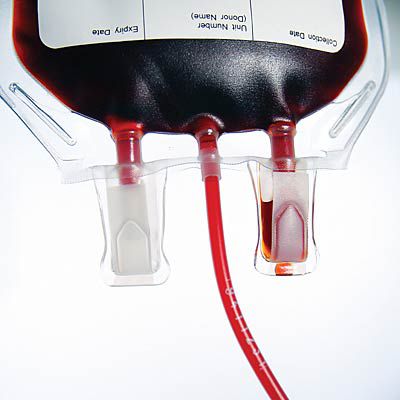Our blood is our life force: It gives us oxygen, nutrients and infection-fighting agents. But it can also bring problems, like anemia and deep-vein thrombosis—issues more common in women than men. Feeling squeamish? No need. Here is everything you have to know to stanch cuts, better understand test results and keep your blood flowing freely.
Problem No. 1: Anemia
The lowdown: If you've got this blood disorder—one of the most common—you don't possess enough healthy red blood cells to carry adequate oxygen to your tissues. Anemia is typically caused by not having sufficient iron in your body to make red blood cells, and/or by blood loss due to heavy periods. Mild anemia is fairly common during pregnancy, since your blood volume increases by 20 to 30 percent, which means you need to produce more red blood cells to keep up. Other types of anemia include vitamin-deficiency anemia, caused by low levels of vitamin B12 or folate, and pernicious anemia—a condition in which your gastrointestinal tract is unable to absorb B12.
What it feels like: "You can't exert yourself the way you used to," says Louis Aledort, MD, a hematologist at Mount Sinai School of Medicine in New York City. You might be tired, breathless or dizzy for no reason.
Rx: Your doctor will run a complete blood count (CBC) to check that your red blood cells and hemoglobin levels are high enough. Make sure the red blood cells are also checked for size and color—you can have mild early-stage anemia that doesn't show up on a CBC but is indicated by telltale small, pale cells (they should be larger and red). If you have heavy periods, your ob-gyn may put you on hormonal birth control, or send you for surgery to remove fibroids if those are causing the problem. Otherwise, you'll likely be advised to pop an iron supplement or eat more iron-rich foods, such as beans, lentils and dark green leafy veggies.
RELATED: 15 Signs You May Have an Iron Deficiency
Problem No. 2: Abnormal blood clots
The lowdown: Clots help stop bleeding when the body has been injured. But sometimes they form without a known cause, says Andrew Schafer, MD, a hematologist at New York–Presbyterian Hospital/Weill Cornell Medical Center in New York City. If a clot forms deep in your body, like your lower leg or thigh—a condition known as deep-vein thrombosis (DVT)—and breaks off and travels to your lungs, you could develop a potentially life-threatening condition known as pulmonary embolism (PE). You're especially at risk if you're pregnant or taking hormonal birth control or hormone therapy, since higher-than-normal estrogen levels increase the likelihood of clots. You're also more susceptible to DVT or PE if you smoke, are overweight or are sitting for a long period of time, like on a plane.
What it feels like: Cramping, pain or swelling in one leg is a hallmark of DVT, often starting in your calf and progressing down to your foot.
Rx: If you suspect you have DVT, see your doctor immediately or head to the ER. The standard treatment is blood-thinning medication, such as heparin and warfarin. Know you're going to be seated for a while? Keep DVT at bay by getting up to walk around every couple of hours.
Problem No. 3: Bruising
The lowdown: Bruises form when capillaries under the skin are broken by an injury; blood leaks out, causing that black-and-blue mark. You're more prone to them as you age and your skin thins, as well as if you're taking blood-thinning meds or steroids to treat allergies, asthma or eczema, which thin skin.
What it feels like: In addition to seeing the gruesome color, you may feel slight pain or tenderness at the bruise site.
Rx: If you, say, knock your shin and want to fend off a bruise, try applying ice immediately to help your blood vessels contract and stop the bleeding. You can also rub some arnica gel (found in health-food stores) on the spot daily, which may promote white blood cell activity, says Debra Jaliman, MD, a dermatologist at Mount Sinai School of Medicine.
To get our top stories delivered to your inbox, sign up for the HEALTH newsletter
Problem No. 4: Antiphospholipid syndrome
The lowdown: This disorder occurs when your immune system mistakenly produces antibodies against blood proteins related to clotting. The result: Your blood may clot abnormally, increasing risk of conditions like DVT. You're also more susceptible to pregnancy complications, such as miscarriages or preeclampsia. There's no known cause for the syndrome, but it's sometimes associated with having an autoimmune problem, like lupus.
What it feels like: Usually nothing, which is why it's often detected after you've already had DVT or trouble initiating or maintaining a pregnancy. Some people may experience clotting, shortness of breath, chest pain and swelling.
Rx: In the majority of cases, blood-thinning medication and baby aspirin will help. The good news: Most women respond well to treatment.
